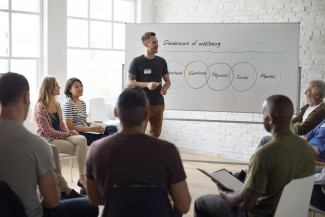
Johns Hopkins UniversityEst. 1876
America’s First Research University
Building Healthy Communities through Medical-Religious Partnerships

Why should medical organizations look to faith communities as partners for health programs? Haven’t religious institutions lost their influence in America?
These are questions I am sometimes asked when people learn that much of my work is devoted to building alliances between medical organizations and religious congregations, especially if they have heard about a 2012 report from the Pew Forum on Religion and Public life that received widespread attention. This report, cleverly titled “Nones on the Rise: One-in-Five Adults Have No Religious Affiliation,” revealed that between 2007 and 2012 the number of Americans who reported no religious affiliation (“nones”) increased from just over 15% to just under 20%. While this is certainly a significant increase, the authors note that almost all of this growth in the numbers of religiously unaffiliated occurred among young adults, and they go on to present survey results that demonstrate the United States remains a “highly religious country.” For example, 90 percent of adults ages 65 and older reported a religious affiliation, as did 84 percent of those in the 50- to 64-year-old age group. And even among younger generations, the majority of adults still reported being religiously affiliated – 77 percent of those ages 30-49 and 67 percent of young adults ages 18-29.
Another important finding about religious affiliation and participation, especially given the growing diversity of the U.S. population and our recognition of persistent health disparities among African Americans and Hispanic/Latino adults that must be addressed, is that regular attendance is higher among these two groups than among non-Hispanic/Latino whites. Furthermore, African American and Hispanic/Latino adults are more likely to report that religion is important in their daily lives, when making personal decisions, and as part of their identity.

Additional evidence of the potential impact of faith communities can be found in the book, American Grace: How Religion Divides and Unites Us by Robert Putnam of Harvard University and David Campbell of the University of Notre Dame. These social scientists report that religious individuals have high rates of volunteerism, and this extends to volunteering for secular groups as well as religious groups. They also note that highly religious individuals are more likely to serve as an officer or committee member of organizations and to have “worked together with others to solve a community problem.” And they are more generous with their charitable contributions, being more likely to donate financially to secular causes. Another interesting finding reported by Putnam and Campbell is that “most Americans, whatever their own degree of religiosity, seem to have a trust bias in favor of religious people.” Even though there may be no direct evidence that religious individuals are more trustworthy than nonreligious individuals, it seems most Americans believe they are. This perceived trustworthiness is certainly important when they are helping deliver health information to members of their community.
These and other findings strongly suggest that if you want to initiate any new program in a community, especially one with a focus on the physical or emotional needs of the residents, faith communities are an ideal starting point. Religious congregations are where you will find individuals who have large social networks, are active in other community organizations, give generously of their time and money, and typically are viewed by others as trustworthy. This is exactly what we have found over the past 25 years and reported in our recent book, Building Healthy Communities through Medical-Religious Partnerships (3rd edition). Through programs that have brought together the expertise and resources of the medical community with the dedication and energy of volunteers from religious congregations, people have become more knowledgeable about important medical issues and the medical services available in their communities as well as more skillful in working with their own physicians and other healthcare providers.
W. Daniel Hale, PhD, is a clinical psychologist who serves as special advisor to the president of Johns Hopkins Bayview Medical Center and director of the hospital’s Healthy Community Partnership. He is the coauthor of Building Healthy Communities through Medical-Religious Partnerships and Healing Bodies and Souls: A Practical Guide for Congregations.


